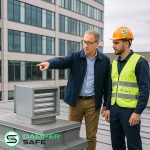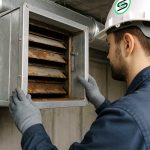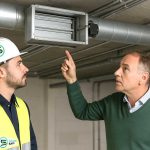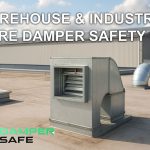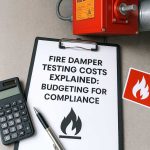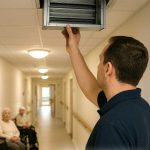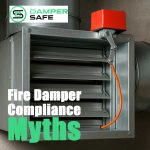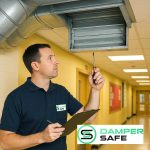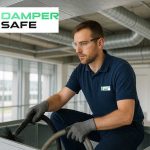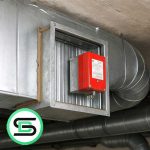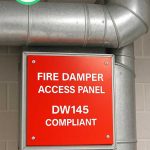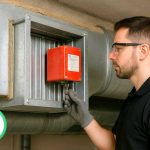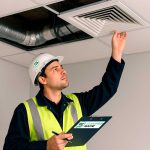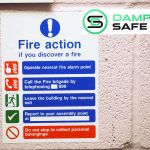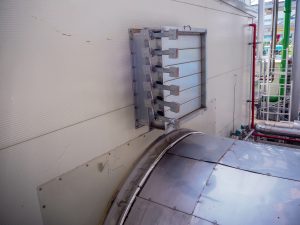 At Damper Safe Ltd, we specialise in the installation of fire dampers to ensure compliance with UK regulations and enhance fire safety in both commercial and residential buildings. Here, we outline the best practices for installing fire dampers, which reflect the highest standards in fire protection.
At Damper Safe Ltd, we specialise in the installation of fire dampers to ensure compliance with UK regulations and enhance fire safety in both commercial and residential buildings. Here, we outline the best practices for installing fire dampers, which reflect the highest standards in fire protection.
- Understanding Regulations and Standards
- Building Regulations: We ensure all installations comply with Approved Document B (ADB), which details fire safety requirements, including fire damper use in buildings.
- BS 9999: Our work aligns with this code of practice for fire safety in the design, management, and use of buildings.
- BS EN 1366-2: All fire dampers installed by Damper Safe Ltd meet the rigorous fire resistance testing standards required by UK regulations.
- Positioning Fire Dampers
- Duct Penetrations: We install fire dampers where ductwork penetrates fire-rated walls, floors, or partitions to maintain the fire-resisting compartmentation of your building.
- Access for Maintenance: We always position fire dampers to allow easy access for inspection and maintenance, often incorporating access panels in the ductwork.
- Avoiding Obstacles: We ensure that dampers are installed in clear locations, free from obstructions like beams or other services, guaranteeing their proper functionality.
- Installation Types
- Curtain Type Fire Dampers: These are the most commonly used fire dampers, and we ensure they are fitted with blades that close automatically in the event of a fire.
- Intumescent Fire Dampers: We install these in smaller duct applications where traditional dampers may not be suitable. These dampers expand when exposed to heat, sealing the duct effectively.
- Integration with Fire Alarm Systems
- For commercial installations, we ensure fire dampers are connected to the Building Management System (BMS) or fire alarm system to trigger automatic closure during a fire.
- We use motorised or actuator-fitted dampers for automated closure, ensuring the system responds promptly to fire conditions.
- Correct Sealing and Support
- Sealing: We use only approved fire-resistant sealants around ductwork where it penetrates fire-rated structures, ensuring there are no gaps for smoke or fire to pass through.
- Duct Support: Our team ensures the ductwork is securely supported near the damper to avoid misalignment or stress, which could hinder damper performance.
- Correct Fire Damper Sizing
- At Damper Safe Ltd, we ensure all dampers are correctly sized for the ducts they serve. This prevents improper sealing, ensuring maximum fire containment effectiveness.
- Installation with Fire-Rated Ducts
- We always use fire-rated ducts with the appropriate fire resistance duration, ensuring the integrity of the entire system during a fire. Both the fire damper and the ductwork must provide adequate fire resistance.
- Regular Inspection and Testing
- Maintenance Schedule: As part of our service, we recommend and conduct annual inspections and testing of fire dampers, following the guidelines outlined in BS 9999. This ensures the dampers remain free from obstructions and are fully operational.
- Operational Testing: During these checks, our engineers manually test the dampers to verify they close completely and latch securely.
- Use of CE Marked Products
- We only use CE marked fire dampers, which comply with both UK and European safety standards. This ensures the dampers have undergone rigorous testing and meet all fire performance requirements.
- Labelling and Documentation
- Every fire damper we install is clearly labelled with its fire resistance rating, installation date, and the most recent maintenance check. We also provide thorough documentation for fire safety audits, ensuring your compliance with all regulations.
- Professional Installation
- All of our installations are carried out by qualified professionals who are experienced with UK fire safety standards and ventilation systems. This ensures a reliable and safe installation every time.
- Residential vs. Commercial Considerations
- Residential: For residential properties, fire dampers tend to be smaller but no less critical. We ensure correct placement to maintain compartmentation in case of fire.
- Commercial: In larger commercial buildings, ventilation systems are often more complex. We install fire dampers that integrate seamlessly with fire alarms and Building Management Systems, ensuring a robust fire protection system.
At Damper Safe Ltd, we pride ourselves on adhering to the highest standards of fire safety, ensuring your building is fully protected and compliant. Regular maintenance and inspections, paired with professional installation, are key to keeping your fire dampers in optimal working order.

